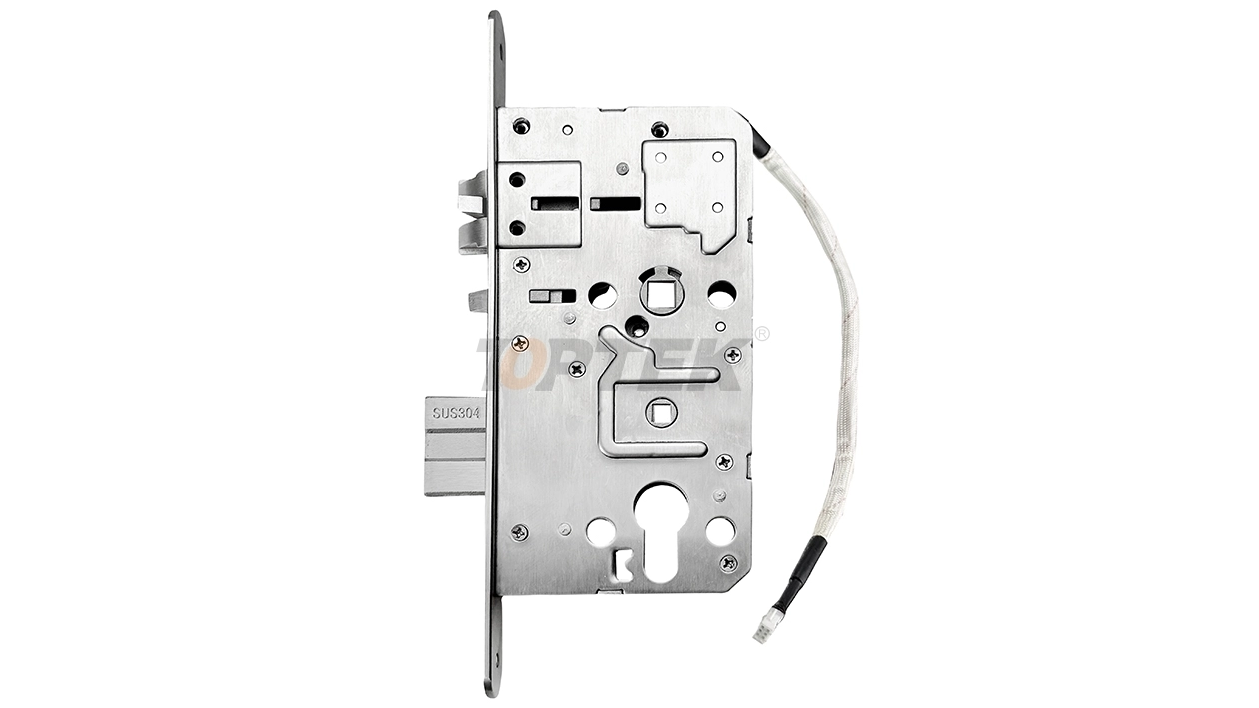Properly installed commercial door hardware is essential for the security, functionality, and safety of any business premises. Unlike residential hardware, commercial-grade products are built to withstand high traffic and heavy use while complying with strict building codes. Getting the installation right the first time prevents costly repairs, ensures accessibility, and protects your assets.
This guide provides a comprehensive overview of how to install commercial door hardware correctly. We will walk you through the necessary preparations, the step-by-step installation process for common components like locks and closers, and the final checks needed to guarantee a perfect setup. Following these instructions will help you achieve a secure and professional installation that lasts.
Gearing Up for Installation
Before you begin, gathering the right tools and materials is crucial for a smooth and efficient process. A well-prepared workspace minimizes delays and helps you avoid common installation mistakes.
Essential Tools and Materials
Having the correct tools on hand is non-negotiable. While the specific tools may vary slightly depending on the type of hardware, a standard kit should include:
· Drill with various bit sizes: For creating pilot holes and securing screws.
· Screwdriver set: Both Phillips and flat-head screwdrivers are necessary.
· Tape measure: For precise measurements of the door and frame.
· Level: To ensure all components are perfectly aligned.
· Chisel and hammer: For mortising, if you are installing hardware that needs to be recessed into the door.
· Safety glasses: To protect your eyes from dust and debris.
· Pencil or marker: For marking drilling and cutting points.
· Manufacturer's template: Most commercial door hardware comes with a paper template to guide drilling. Do not lose this!
Preparing the Door and Frame
Once your tools are ready, the next step is to prepare the door and frame. A clean and accurately marked surface is the foundation of a successful installation.
1.Inspect the Door: Check the door for any damage, such as warping or cracks, that could interfere with the hardware's function. Ensure the door is properly hung and swings freely without catching on the frame.
2.Use the Template: Carefully position the manufacturer-provided template on the door. Secure it with tape. The template will show you exactly where to drill holes for the lockset, latch, and other components.
3.Mark Drilling Points: Use a pencil or an awl to mark the center of each hole indicated on the template. Double-check your marks for accuracy before proceeding. An incorrect measurement at this stage can lead to misaligned hardware.
4.Prepare the Frame: Mark the location for the strike plate on the door frame. This should align perfectly with the latch bolt when the door is closed.

How to Install a Commercial Lockset
The lockset is the heart of your door's security. Commercial locksets, such as cylindrical or mortise locks, are more robust than their residential counterparts. The installation process requires precision.
Step 1: Drill the Holes
Using the marks you made from the template, begin drilling the necessary holes.
· Face Hole: Drill the main hole through the face of the door for the lock body. Start from one side and drill about halfway through, then complete the hole from the other side. This technique prevents the wood from splintering.
· Latch Hole: Drill the hole into the edge of the door for the latch assembly. Make sure this hole is straight and deep enough to accommodate the entire latch mechanism.
Step 2: Install the Latch
With the holes drilled, you can now install the latch.
1.Slide the latch bolt assembly into the hole on the door's edge.
2.Place the latch plate over the assembly and trace its outline with a pencil.
3.If required, use a chisel to create a shallow mortise so the latch plate sits flush with the door edge.
4.Secure the latch plate with the provided screws.
Step 3: Install the Lock Cylinders
Now, install the main lock components.
1.Insert the exterior lock cylinder (the side with the keyhole) through the large face hole, ensuring its tailpiece passes through the latch mechanism correctly.
2.Attach the interior cylinder or thumb-turn assembly on the other side of the door.
3.Secure both sides together using the mounting screws. Tighten them evenly, but avoid over-tightening, which can cause the lock to bind.
Step 4: Install the Strike Plate
The final piece of the lockset is the strike plate, which goes on the door frame.
1.Close the door to mark where the latch bolt touches the frame.
2.Align the strike plate with this mark and trace its outline.
3.Chisel a mortise for the strike plate so it sits flush with the frame.
4.Drill a hole for the latch bolt to enter.
5.Fasten the strike plate to the frame with screws.
How to Install a Commercial Door Closer
A door closer is a critical piece of commercial door hardware, especially for fire-rated doors and high-traffic entrances. It ensures the door closes automatically, enhancing security and energy efficiency.
Step 1: Choose the Mounting Position
Door closers can typically be installed in one of three ways: standard arm, top jamb, or parallel arm. The parallel arm installation is the most common for commercial applications as it reduces the risk of vandalism. Refer to the manufacturer's instructions and template to determine the best position for your door.
Step 2: Mount the Closer Body
1.Using the provided template, mark the drilling locations for the closer body on the door (for standard or parallel arm installations) or on the frame (for top jamb installations).
2.Drill pilot holes for the mounting screws.
3.Attach the closer body to the door or frame, making sure it is level.
Step 3: Install the Closer Arm
1.The closer arm consists of two parts: the main arm and the forearm. Attach the main arm to the spindle on top of the closer body according to the instructions.
2.Mount the forearm shoe to the door frame (for standard arm) or the door (for parallel arm).
3.Connect the main arm and forearm.
Step 4: Adjust the Closer
After installation, you must adjust the closer's settings for proper operation.
· Closing Speed: Controls how fast the door closes from the fully open position.
· Latching Speed: Controls the speed of the final few inches of closing, ensuring the door latches securely.
· Backcheck: Cushions the opening swing to prevent the door from being slammed against a wall.
Turn the adjustment screws in small increments to fine-tune these settings until the door closes smoothly and latches firmly without slamming.

Your Partner for Quality Hardware
Installing commercial door hardware correctly is a job that demands attention to detail. By following these steps and using the manufacturer's templates, you can ensure a secure and functional installation. Remember that high-quality hardware is just as important as proper installation. For the best performance and durability, source your materials from reputable European commercial hardware suppliers known for their superior engineering and robust products. A well-installed door with top-tier European commercial hardware is an investment in the safety and longevity of your building.
If you feel the task is beyond your comfort level, don't hesitate to contact a professional locksmith or contractor. They have the experience and specialized tools to get the job done right, ensuring your commercial property remains safe and compliant.
Commercial Door Hardware
commercial hardware suppliers
European commercial hardware
English
العربية
Français
Русский
Español
Português
Deutsch
italiano
日本語
한국어
Nederlands
Tiếng Việt
ไทย
Polski
Türkçe
አማርኛ
ພາສາລາວ
ភាសាខ្មែរ
Bahasa Melayu
ဗမာစာ
தமிழ்
Filipino
Bahasa Indonesia
magyar
Română
Čeština
Монгол
қазақ
Српски
हिन्दी
فارسی
Kiswahili
Slovenčina
Slovenščina
Norsk
Svenska
українська
Ελληνικά
Suomi
Հայերեն
עברית
Latine
Dansk
اردو
Shqip
বাংলা
Hrvatski
Afrikaans
Gaeilge
Eesti keel
Māori
සිංහල
नेपाली
Oʻzbekcha
latviešu
অসমীয়া
Aymara
Azərbaycan dili
Bamanankan
Euskara
Беларуская мова
भोजपुरी
Bosanski
Български
Català
Cebuano
Corsu
ދިވެހި
डोग्रिड ने दी
Esperanto
Eʋegbe
Frysk
Galego
ქართული
guarani
ગુજરાતી
Kreyòl ayisyen
Hausa
ʻŌlelo Hawaiʻi
Hmoob
íslenska
Igbo
Ilocano
Basa Jawa
ಕನ್ನಡ
Kinyarwanda
गोंगेन हें नांव
Krio we dɛn kɔl Krio
Kurdî
Kurdî
Кыргызча
Lingala
Lietuvių
Oluganda
Lëtzebuergesch
Македонски
मैथिली
Malagasy
മലയാളം
Malti
मराठी
ꯃꯦꯇꯥꯏ (ꯃꯅꯤꯄꯨꯔꯤ) ꯴.
Mizo tawng
Chichewa
ଓଡ଼ିଆ
Afaan Oromoo
پښتو
ਪੰਜਾਬੀ
Runasimi
Gagana Samoa
संस्कृत
Gaelo Albannach
Sepeti
Sesotho
chiShona
سنڌي
Soomaali
Basa Sunda
Wikang Tagalog
Тоҷикӣ
Татарча
తెలుగు
ትግንያውያን
Xitsonga
Türkmençe
संस्कृत
ئۇيغۇرچە
Cymraeg
isiXhosa
ייִדיש
Yorùbá
isiZulu







































